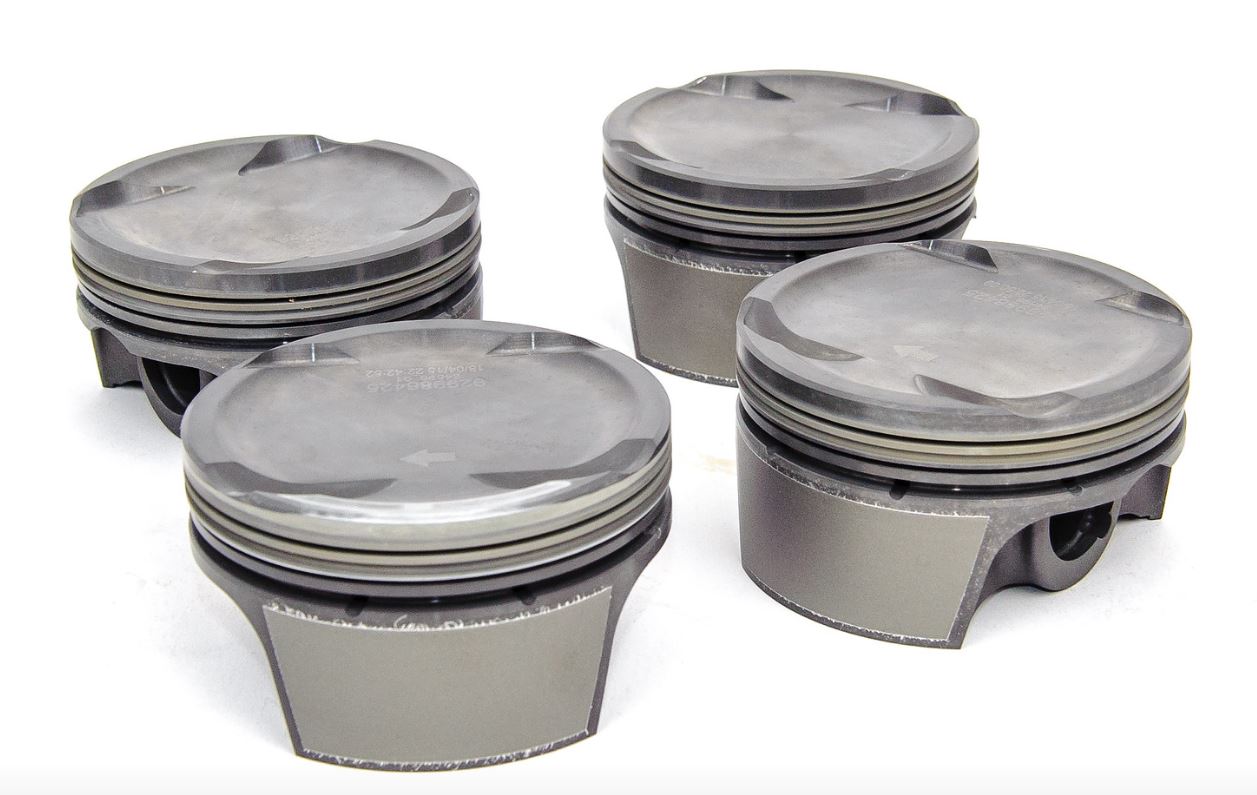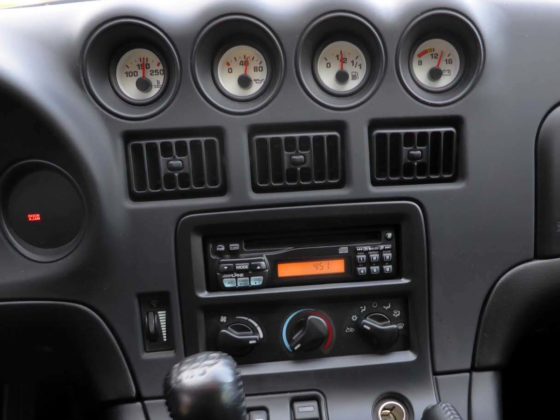The stock block F20c/F22c is well-known for being very stout. Many S2000s have been turbocharged to over 600whp without ever being opened up. However, our base target is 500 crank horsepower on Cali 91 octane while going through a catalytic converter with a mild exhaust. The only way to achieve that goal is to dive into the engine to lower the compression ratio.

In the 1990’s, Honda developed their Fiber Reinforced Metal (FRM) liners which is also known as a Metal Matrix Composite (MMC). The goal of the FRM liner was to eliminate the need for the cast iron (i.e. heavy) liner typically required for use with aluminum pistons. Aluminum on aluminum is a bad mix when it comes to a sliding interface; tribology is the study of materials sliding relative to each other in case you were wondering. One of the solutions was the introduction of the FRM liner. The downside of the FRM liner is the requirement for coatings on the piston to be compatible.
Enter Mahle with their Gold Series piston for use in FRM liners. The Gold Series Anti-Friction Skirt Coating is the secret sauce allowing the piston to work with the FRM liner. For the Manufacturing Engineering geeks, you can see the time/date/lot info etched into the top of the piston. Mahle is a huge supplier to the OEM automotive industry, so they do these OEM type things. Of course, they do motorsports things too like helping win the 24 Hours of Le Mans many times in boosted applications. For our turbo F22c, the compression ratio is a forced induction friendly 9.5:1 compared to the stock 11.0:1. We should have no worries at all with knock on 91 octane pump gas at our initial 15psi target.

To handle the boost we’re going to throw at the engine, the Mahle pistons start out life as a forging of 2618 alloy aluminum. The generous fillet radii you see in the forging are excellent at reducing stress risers.

The top ring groove is hard anodized to handle the high stress of high cylinder pressures and high piston speeds. With the Hondata K-Pro, we bumped up our redline to 8500rpm for those instances where we need to wind it out just a little more than the stock 8200rpm of the F22c. Mahle uses a phosphate coating on the piston which gives the piston the grey appearance. Phosphate is a dry lubricant and the application in the pin bores and ring grooves protects against galling and micowelding during a cold start before the oil gets moving. There’s that tribology stuff again.

The Mahle PowerPak includes all the piston rings and piston pin, so you’re good to go. I had the opportunity to work on some piston pin design a while back and this pin design is pretty stiff. It has a thick wall and no tapering/chamfer of material at the ends of the pin. Mahle has an excellent series of books you can buy on engine component design where I learned about this stuff.

Transferring the combustion pressure to the crank are Carrillo PRO-H connecting rods. According to the crew at Real Street Performance, these rods are good for around 275hp each. We’re only looking to push about 125hp a rod, so we have plenty of safety margin. Yes, torque is the more proper unit for strength, but everyone is more use to thinking in terms of horsepower. Anyway, we will have tons of fatigue life as the rods will be significantly under-stressed. The rods get their strength through a number of material processing features. The first process being forging of the material. The rods are heat treated to reduce internal stresses. Lastly, the rods are shot peened to improve fatigue strength. Check out the small end bushing which has holes to help feed oil to the piston pin.




21 comments
Love the work you’re doing. Any idea how much the inconel manifold will cost?
I budgeted ~$4k for it. I’m planning to get it and the turbine housing coated with SwainTech White Lightning for thermal management.
Awesome write up! Now I want to build a motor.
Did you do any prep on the block with the FRM sleeves? Just a hone or no hone at all? I’ve never messed with FRM lined sleeves so I’d love to hear your thoughts/how you handled that part of the block rebuild. Thanks.
I don’t believe my block required any honing. It did only have 70k miles on it. That said, there’s a very specific procedure with specific honing stones listed in the factory service manual. I went with the Mahle pistons in the standard 87.00mm bore but they are also available in 87.25mm bore.
Excellent write up! Can’t wait to see your thoughts once it’s turbocharged.
I spy some 999MP-1217HP Nissan 3bond sealant on the 3rd page, if it’s good enough for a GT-R its good enough for just about everything else lol.
Most of us MotoIQ guys are old school Nissan guys!
Great detail in the build. I love the paths to reliability and not cutting corners approach.
One question about the manifold/hot side setup. What was the reason you opted for an external wastegate vs internal? I would have thought with the tight packaging constraints it would’ve made an internal more desirable but you obviously did it for a reason. Better boost control? Thx!
The way the internal wastegate actuator is angled off the centerline of the turbo makes it pretty wide, so it doesn’t fit. We tried during 3D modeling to see if we could make it fit, but it doesn’t unfortunately. Check out the location of the actuator can vs. the turbine inlet flange and you’ll see why it doesn’t fit.
https://motoiq.com/project-s2000-part-25-designing-a-custom-turbo-setup-with-3d-scanning-cfd-fea-and-3d-printing/3/
It would maybe be possible with a regular rotation turbo, but then you basically have to make a sharp 90 degree turn out of the cylinder head, i.e. Greddy and SOS TS-Max turbo kits. And we know how those flow on the topend. Or you have to low mount the turbo, i.e. PTuning. And they had to make a custom engine mount.
Gotcha, thx for the response Khiem. I figured there was a reason. A shame the engine bay is so tight right by the exhaust ports, but the engineers obviously never planned for a turbo.. The concern with an external wastegate is one more component and the heat on track. I’ve heard from a couple people where the diaphragms fail due to the heat. I guess no such thing as a perfect turbo setup for this car..
Tial came to market with water cooled EWGs awhile ago due to failures in track use. The first one I knew of was on the old StopTech Evo X time attack car I helped out with. As the EWG was on the backside of the engine, it got no cooling airflow. Turbosmart has water cooled EWGs now. And if you read the fine print, at least on the Turbosmart EWG that are not water-cooled, it says to make sure there’s good airflow to the EWG. In serious track use, IWG are more prone to fail due to the wastegate flapper/poppet valve breaking off. Though on the newer Garrett OEM gasoline turbos in high performance applications, they have a solid one-piece arm and valve assembly. No more poppet valve to break off. There’s still potential for the arm seizing in the bushing though.
Ya I heard about the EWG’s with coolant ports to fix the problem, but for a street/track car more for fun vs a hardcore track car probably a bit much imo. Ya “serious” track use is a term that varies based on different people. :p I was mainly thinking fun for HPDE’s and being able to run 15-20min sessions. An IWG would suffice for someone like me.
Did you do any work to the actually block or clinder walls?
Deck, Hone or bore.
Hello i have s2000 f22 with kraftwerks.
Please recomend best setup for oil engine cooler
Hello khiem, i have s2000 ap2 stock engine with kraftwerks supercharger. What oil cooler engine recommend. This kit include Intercooler front.
What position do you recommend to install the oil cooler, behind the radiator? Please give me technical recommendations to make a good assembly. I really appreciate your collaboratio
Hello khiem, i have s2000 ap2 stock engine with kraftwerks supercharger. What oil cooler engine recommend. This kit include Intercooler front.
What position do you recommend to install the oil cooler, behind the radiator? Please give me technical recommendations to make a good assembly. I really appreciate your collaboratio
You can do a setup similar to mine if you need a lot of oil cooling, so it’ll be custom. If your use case is just some occasional hard driving, you would probably do just fine with an available S2000 oil cooler kit. I would suggest doing research on your kraftwerks supercharger kit.
What is your current oil cooling setting? you already have the turbo car. What would be my best street oil option?
This is the my setup that I’ve been running for years. It sounds like your best bet is to have a shop do a custom setup for you.
https://motoiq.com/project-s2000-oil-cooling/